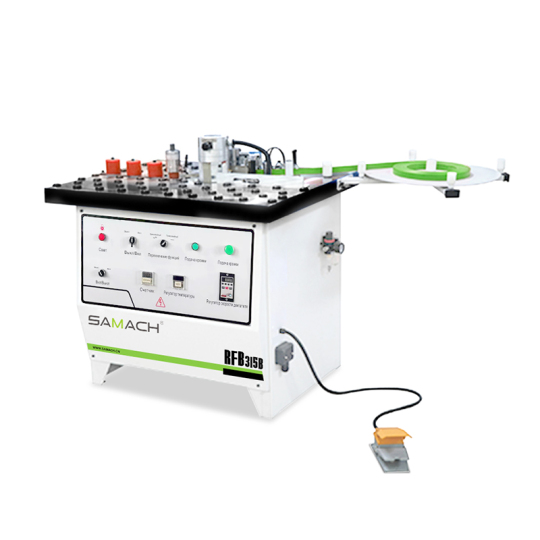
## Edge Banding Machines in 2025: Why They’re Essential
In modern cabinet and furniture production, the Edge Banding Machine delivers premium finishes and durable performance by sealing exposed panel sides with PVC, ABS, veneer, or melamine.
Whether you run a boutique workshop or a high-throughput plant, the right edgebander raises quality while shortening changeovers.
## Edge Banding Machine: Definition
An Edge Banding Machine seals panel edges with tape and processes it to create a durable joint.
Typical stations include: preparation, adhesive application, tape feeding with pressure rollers, end cut, top/bottom trim, and fine finishing.
## Edge Banding Process: Step by Step
1. In-feed & Alignment — A guided in-feed keeps parts straight and stable.
2. Edge Squaring — Pre-milling improves bond quality and appearance.
3. Adhesive — Thin, consistent glue lines improve durability.
4. Tape Bonding — Stable feed avoids drift.
5. End Cut — Clean ends define the part geometry.
6. Flush Trimming — Accurate tracking minimizes tear-out.
7. Corner Rounding (if equipped) — Improves safety and aesthetics.
8. Scraping & Buffing — Ready-for-install finish.
## Edge Bander Types
• Manual/Portable — lowest cost, on-site fixes, but variable quality and slow throughput.
• Starter Auto — simple stations, good upgrade from manual methods.
• Mid-Tier — better finish (pre-mill + corner round), faster changeovers, lower rework.
• Industrial Lines — invisible glue lines, auto setup, MES/ERP connectivity.
• Curve Banders — supports non-straight edges; slower but flexible.
## EVA vs PUR vs Zero-Joint
• EVA Hot-Melt — affordable and easy to clean, but lower heat/moisture resistance and more visible glue lines on dark colors.
• PUR Hot-Melt — thin glue line, excellent resistance, strongest bond; requires strict handling/cleaning.
• Zero-Joint — no liquid glue pot; perfect aesthetics with matched functional layers.
Tip: Stock EVA + PUR if your machine supports quick glue-pot swaps.
## Key Specifications to Compare
• Feed speed (~8–23 m/min) — higher speed raises throughput; match upstream CNC capacity.
• Thickness range — ensure it fits your product mix.
• Tape thickness — 0.4–1 mm (lightweight) vs 2–3 mm (robust edges).
• Pre-mill — crucial for tight glue lines and reduced rework.
• Corners — important for doors/drawer fronts.
• Scraping/Buffing — final finesse on gloss/super-matt.
• Glue tech — drives TCO, appearance, and process control.
• Control — recipe library reduces operator error.
• Extraction — cleaner edges and safer air.
• Setup time — critical for short runs.
• Utilities — verify power, air, space.
## Best-Fit Recommendations
• Boutique makers — mid-tier with strong finishing stations.
• Projects & more info rollouts — prioritize speed + consistency.
• Showpiece finishes — invest in zero-joint.
• High volume — thick tape support + conveyors.
• First automation step — entry auto with EVA glue pot and essential trimming/scraping.
## Run It Right: Practical Tips
• Stabilize environment; verify three-phase power, air, and dust extraction.
• Pre-mill lightly for best ROI.
• Tune glue temperature/viscosity per spec; avoid overheating EVA; handle PUR carefully.
• Calibrate pressure rollers—too low = weak bond, too high = squeeze-out.
• Planned sharpening reduces scrap.
• Housekeeping is quality control.
• Culture of safety = fewer surprises.
## Diagnose & Correct Fast
• Visible glue line — raise temp within spec, add pressure, verify pre-mill; consider PUR/zero-joint for dark/gloss.
• Corner peel — refine rounding, ensure activation/press time, clean surfaces.
• Veneer fuzz — sharp tools and gentler passes.
• Excess glue — tune gap/pressure.
• Tracking off — align fences and tape feed.
## Materials & Tape Choices
Match tape to application: PVC/ABS for durability.
Zero-joint success depends on color matching.
## Boosting Throughput with Integration
Connect your edgebander with nesting CNC, return conveyors, automated in/out-feed, and MES/ERP for continuous flow.
## Greener Edge Banding Choices
Durable seams mean fewer replacements over product life.
## FAQs (SEO)
Ideal feed speed? Start with OEM recommendations, then tune for adhesive and tape thickness.
EVA vs PUR? EVA is cheaper to clean; PUR resists heat/moisture with a thinner line.
Pre-mill worth it? Key to invisible seams.
Zero-joint explained: Seamless look.
When to sharpen? Avoid dull cuts.
## Bottom Line
With solid setup and maintenance, the right edgebander improves margins on every shift. }